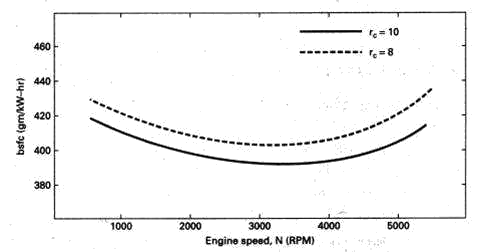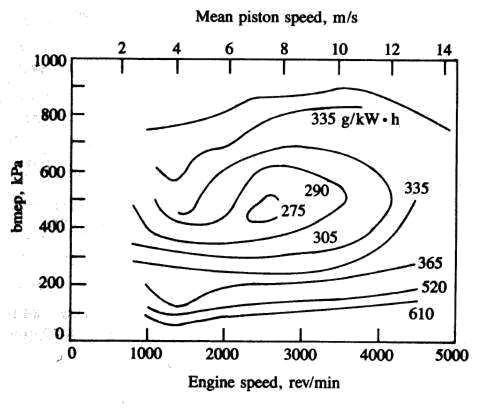FF
Guru
- Joined
- Oct 12, 2007
- Messages
- 22,552
<h3>Found this on a site , and although its not "marine diesels" (usually marinized* truck engines) the principals are the same.</h3>
Notice the position in the graph for max hp is not the same as the region for lowest fuel burn.
"hp.performance map which shows an engine's BSFC over the entire load (BMEP) and speed (N) range"
The REAL thing to learn from this graph is at the bottom of the graph where minor HP costs BOODLES of fuel , for very little power.
This shows that it can be really expensive to have a bigger engine than necessary.
IF these fuel maps were avilable for the common marine conversions , it would be really EZ to set up a boat for best economy , and retain extra power for adverse headwinds or seas.<h3></h3><h3>Specific Fuel Consumption</h3> <h4>By Sean Kelly</h4>
Specific fuel consumption is based on the torque delivered by the engine in respect to the fuel mass flow delivered to the engine. Measured after all parasitic engine losses is brake specific fuel consumption [BSFC] and measuring specific fuel consumption based on the in-cylinder pressures (ability of the pressure to do work) is indicated specific fuel consumption [ISFC].





BSFC is directly proportional to engine volume, EG: as engine volume goes down so does BSFC. This is due to the heat losses from the end gas to the cylinder walls. The heat loss drops the thermal efficiency of the engine. This can be observed in the cylinder surface area to cylinder volume ratio, which increases with cylinder bore B:


Every engine has a minimum on the plot of BSFC versus Engine speed N.
Higher engine speeds produce a high BSFC (more fuel consumption for the same torque) because of rising friction losses in the engine. Higher friction losses reduce brake torque [d(Wb)/dt], which increases BSFC [eqn 1. above].
Lower engine speeds produce a higher BSFC (more fuel consumption for the same torque) because of increased time for the heat transfer from the working fluid to the cylinder walls. This reduces [d(W<sub>i</sub>)/dt] ], which increases BSFC.
Compression ratio r<sub>c</sub> is inversely proportional to BSFC due to higher thermal efficiency. That is, higher compression ratio yields lower specific fuel consumption.

Above is a performance map which shows an engine's BSFC over the entire load (BMEP) and speed (N) range. A dynamometer is used to calculate brake torque and fuel flow is entered into the computation to calculate brake specific fuel consumption. This map only incorporates the wide-open throttle condition, but adding a third independent axis of throttle position can create a 3D performance map; it is noted that throttling directly affects efficiency via an inverse proportion, and maximum efficiency and minimum BSFC is realized at 100% throttle.
BMEP is brake mean effective pressure in the cylinder and is the scale of measurement for an engine's potential to produce torque.

N = engine speed, revolutions/minute
T = torque, N*m
V<sub>d</sub> = Displacement, liters


Notice the position in the graph for max hp is not the same as the region for lowest fuel burn.
"hp.performance map which shows an engine's BSFC over the entire load (BMEP) and speed (N) range"
The REAL thing to learn from this graph is at the bottom of the graph where minor HP costs BOODLES of fuel , for very little power.
This shows that it can be really expensive to have a bigger engine than necessary.
IF these fuel maps were avilable for the common marine conversions , it would be really EZ to set up a boat for best economy , and retain extra power for adverse headwinds or seas.<h3></h3><h3>Specific Fuel Consumption</h3> <h4>By Sean Kelly</h4>
Specific fuel consumption is based on the torque delivered by the engine in respect to the fuel mass flow delivered to the engine. Measured after all parasitic engine losses is brake specific fuel consumption [BSFC] and measuring specific fuel consumption based on the in-cylinder pressures (ability of the pressure to do work) is indicated specific fuel consumption [ISFC].





BSFC is directly proportional to engine volume, EG: as engine volume goes down so does BSFC. This is due to the heat losses from the end gas to the cylinder walls. The heat loss drops the thermal efficiency of the engine. This can be observed in the cylinder surface area to cylinder volume ratio, which increases with cylinder bore B:


Every engine has a minimum on the plot of BSFC versus Engine speed N.
Higher engine speeds produce a high BSFC (more fuel consumption for the same torque) because of rising friction losses in the engine. Higher friction losses reduce brake torque [d(Wb)/dt], which increases BSFC [eqn 1. above].
Lower engine speeds produce a higher BSFC (more fuel consumption for the same torque) because of increased time for the heat transfer from the working fluid to the cylinder walls. This reduces [d(W<sub>i</sub>)/dt] ], which increases BSFC.
Compression ratio r<sub>c</sub> is inversely proportional to BSFC due to higher thermal efficiency. That is, higher compression ratio yields lower specific fuel consumption.

Above is a performance map which shows an engine's BSFC over the entire load (BMEP) and speed (N) range. A dynamometer is used to calculate brake torque and fuel flow is entered into the computation to calculate brake specific fuel consumption. This map only incorporates the wide-open throttle condition, but adding a third independent axis of throttle position can create a 3D performance map; it is noted that throttling directly affects efficiency via an inverse proportion, and maximum efficiency and minimum BSFC is realized at 100% throttle.
BMEP is brake mean effective pressure in the cylinder and is the scale of measurement for an engine's potential to produce torque.

N = engine speed, revolutions/minute
T = torque, N*m
V<sub>d</sub> = Displacement, liters


